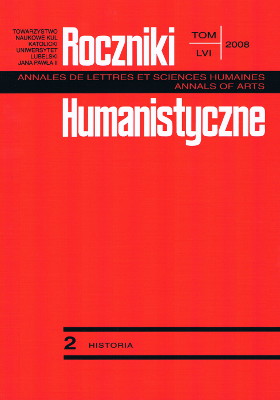The Deed as a Determinant of the Hero’s Greatness. On the Neo-romantic Ideals of Polish Historiography
Abstract
The writing of Szymon Askenazy and his disciples represents the independent line In historiography. Their works were written in the period when political life and thinking were intensive in the Polish territories. They had considerably affected the historical and political awareness of Polish society. The hero’s image created in the historians’ writings drew on to the romantic struggles for freedom. This image of the hero had a didactic dimension in accordance with the principle that “history is the teacher of life.” The deed was one of the basic elements and made up his image. He was often a sufficient factor that decided about the greatness of a hero. Despite the fact that historians glorified above all an armed deed, actions taken by the hero in the area of politics and education were also important. The main place in Askenazy’s school is occupied by the hero who with a weapon in his hands struggles for Poland’s independence, i.e., Prince Józef Poniatowski or Jan Henryk Dąbrowski. The moral authority who embodies the “national virtue” is Tadeusz Kościuszko. Another place is occupied by such persons as Prince Adam Czartoryski or Ksawery Drucki Lubecki. Following these heroes, historians show various forms of the service to our homeland. Their actions were made concrete by their deed. Its basic function in narration was to establish images about the hero. Such images functioned in the historical awareness of society.
References
Askenazy S., Książę Józef Poniatowski 1763-1813, Warszawa 1913; wznowienie: Warszawa 1974.
Barycz H., Szymon Askenazy wśród przeciwieństw i niepowodzeń życiowych i naukowych, w: tenże, Na przełomie dwóch stuleci. Z dziejów polskiej humanistyki w dobie Młodej Polski, Wrocław 1977, s. 237-318.
Daszyk K.K., Szymona Askenazego neoromantyczna apoteoza czynu, „Studia Historyczne” 38(1995), z. 2, s. 225-242.
Filipowicz M., Wobec Rosji. Studia z dziejów historiografii polskiej od końca XIX wieku po II wojnę światową, Lublin 2000.
Grabski A.F., Kształty historii, Łódź 1985.
Kukieł M., Próby powstańcze po trzecim rozbiorze 1795-1797, Kraków 1912.
Kwaśniewski K., Społeczne rodowody bohaterów, Warszawa 1977.
Maternicki J., Historiografia polska XX wieku, cz. 1: Lata 1900-1918, Wrocław 1982.
Micińska M., Między Królem Duchem a mieszczaninem. Obraz bohatera narodowego w piśmiennictwie polskim przełomu XIX i XX wieku (1890-1914), Wrocław 1995.
Skałkowski A., Jan Henryk Dąbrowski (1755-1818), cz. I: 1755-1795, Warszawa 1904.
Copyright (c) 2008 Roczniki Humanistyczne

This work is licensed under a Creative Commons Attribution-NonCommercial-NoDerivatives 4.0 International License.





